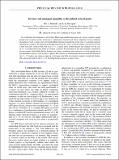| dc.contributor.author | Thorngren, Ryan | |
| dc.contributor.author | Metlitski, Maxim A. | |
| dc.date.accessioned | 2018-09-11T18:44:50Z | |
| dc.date.available | 2018-09-11T18:44:50Z | |
| dc.date.issued | 2018-08 | |
| dc.date.submitted | 2018-06 | |
| dc.identifier.issn | 2469-9950 | |
| dc.identifier.issn | 2469-9969 | |
| dc.identifier.uri | http://hdl.handle.net/1721.1/117718 | |
| dc.description.abstract | It is well known that theorems of Lieb-Schultz-Mattis type prohibit the existence of a trivial symmetric gapped ground state in certain systems possessing a combination of internal and lattice symmetries. In the continuum description of such systems, the Lieb-Schultz-Mattis theorem is manifested in the form of a quantum anomaly afflicting the symmetry. We demonstrate this phenomenon in the context of the deconfined critical point between a Neel state and a valence bond solid in an S=1/2 square lattice antiferromagnet and compare it to the case of S=1/2 honeycomb lattice where no anomaly is present. We also point out that new anomalies, unrelated to the microscopic Lieb-Schultz-Mattis theorem, can emerge, prohibiting the existence of a trivial gapped state in the immediate vicinity of critical points or phases. For instance, no translationally invariant weak perturbation of the S=1/2 gapless spin chain can open up a trivial gap even if the spin-rotation symmetry is explicitly broken. The same result holds for the S=1/2 deconfined critical point on a square lattice. | en_US |
| dc.publisher | American Physical Society | en_US |
| dc.relation.isversionof | http://dx.doi.org/10.1103/PhysRevB.98.085140 | en_US |
| dc.rights | Article is made available in accordance with the publisher's policy and may be subject to US copyright law. Please refer to the publisher's site for terms of use. | en_US |
| dc.source | American Physical Society | en_US |
| dc.title | Intrinsic and emergent anomalies at deconfined critical points | en_US |
| dc.type | Article | en_US |
| dc.identifier.citation | Metlitski, Max A., and Ryan Thorngren. “Intrinsic and Emergent Anomalies at Deconfined Critical Points.” Physical Review B, vol. 98, no. 8, Aug. 2018. © 2018 American Physical Society | en_US |
| dc.contributor.department | Massachusetts Institute of Technology. Department of Physics | en_US |
| dc.contributor.mitauthor | Metlitski, Maxim A. | |
| dc.relation.journal | Physical Review B | en_US |
| dc.eprint.version | Final published version | en_US |
| dc.type.uri | http://purl.org/eprint/type/JournalArticle | en_US |
| eprint.status | http://purl.org/eprint/status/PeerReviewed | en_US |
| dc.date.updated | 2018-08-24T18:00:19Z | |
| dc.language.rfc3066 | en | |
| dc.rights.holder | American Physical Society | |
| dspace.orderedauthors | Metlitski, Max A.; Thorngren, Ryan | en_US |
| dspace.embargo.terms | N | en_US |
| mit.license | PUBLISHER_POLICY | en_US |
